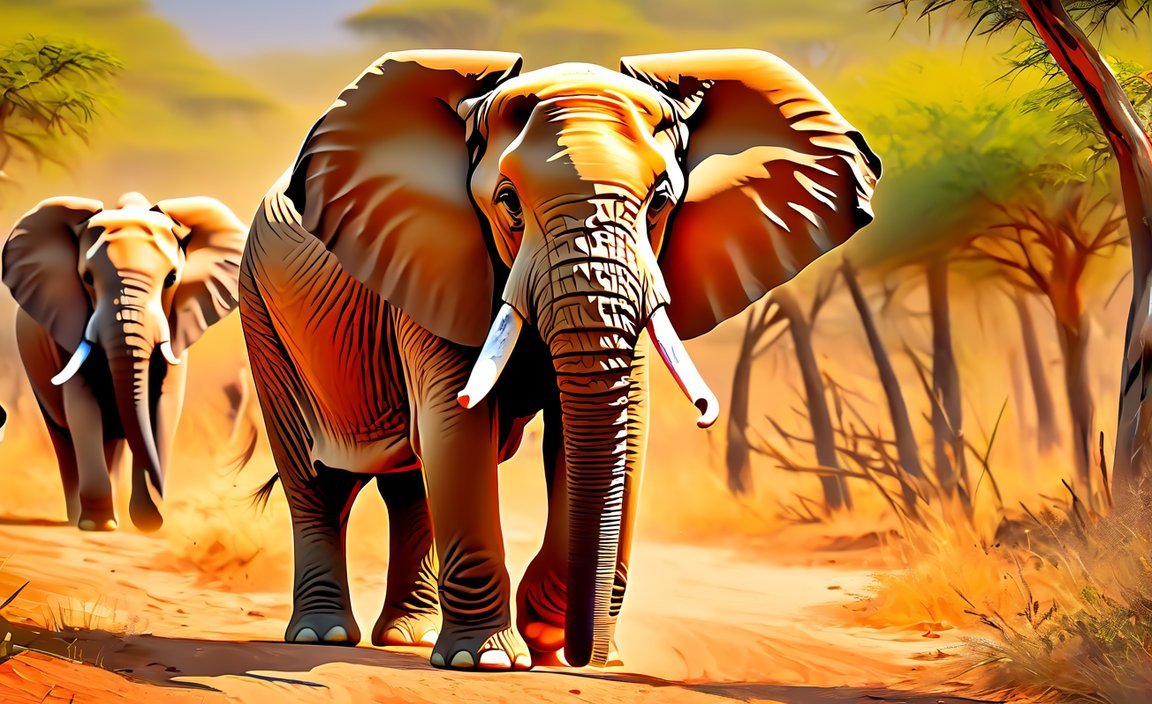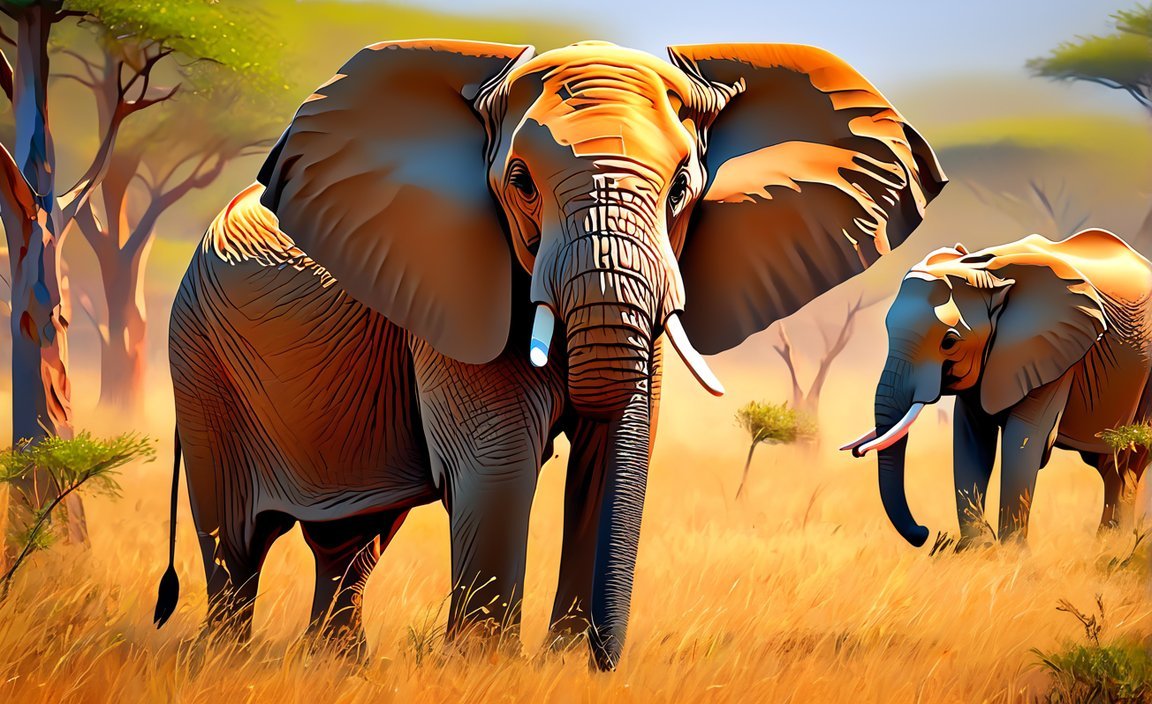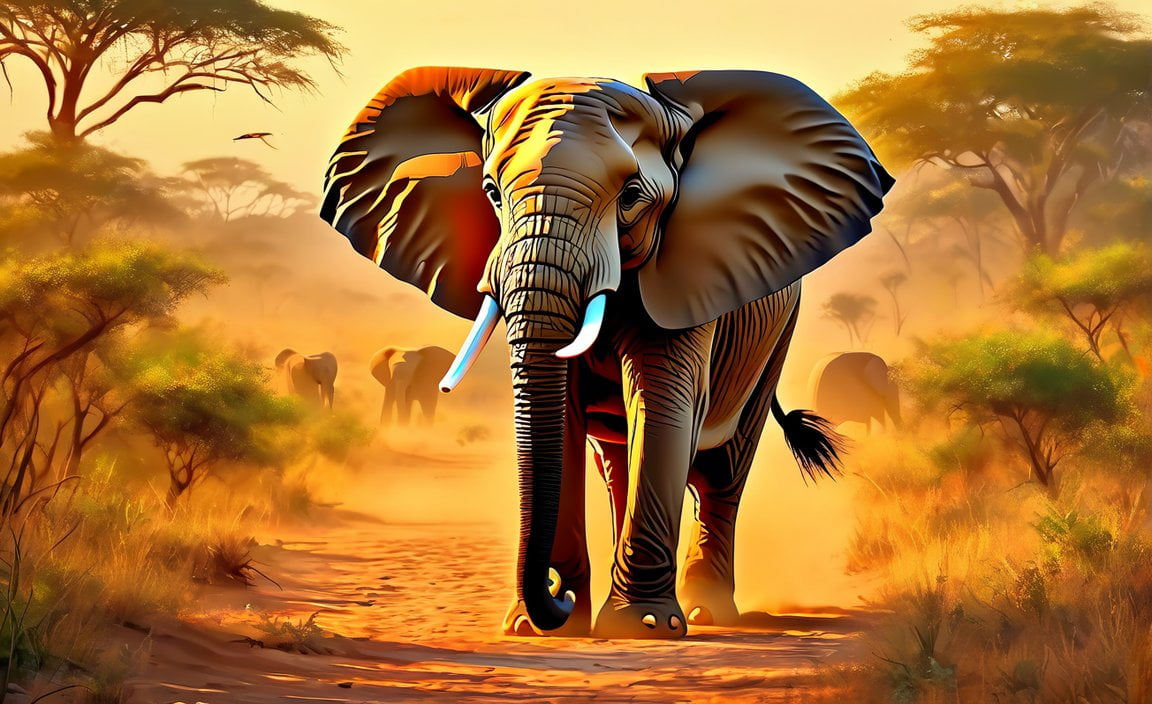Discover the intriguing world of African bush elephants and uncover their unique adaptations with these fascinating facts. As one of the most iconic and majestic creatures on Earth, African bush elephants captivate our imagination with their enormous size, gentle nature, and intricate social structures. In this article, we delve into the realm of these magnificent beings, shedding light on their remarkable adaptations that allow them to thrive in the challenging African savannahs. From their impressive tusks to their intelligent behavior, African bush elephants continue to mesmerize both scientists and wildlife enthusiasts alike.
Key Takeaways:
- The African bush elephant requires 300-350 pounds of vegetation per day.
- The elephant’s tusks are actually their upper incisors.
- African bush elephants have grey skin with scanty hairs and large ears that cover the whole shoulder.
- They can live up to 70 years.
- The trunk of an elephant has over 40,000 muscles and tendons.
- The large ears of African bush elephants help regulate body heat during hot weather.
- They can be found in various habitats such as savannas, deserts, and rainforests.
- Elephant herds are female dominant.
- The African bush elephant can grow up to 24 feet long and 13 feet high.
- They are the largest of the three elephant species and the largest living land mammal in the world.
- The scientific name for the African bush elephant is Loxodonta africana africana.
- African bush elephants have a lifespan of 60 to 70 years.
African Bush Elephant Interesting Facts

The African bush elephant, also known as Loxodonta africana africana, is an extraordinary creature with many captivating facts that make it truly unique. From its massive size to its incredible adaptations, there’s no shortage of fascinating information to explore.
Largest Land Mammal
One of the most remarkable facts about the African bush elephant is its size. As the largest living land mammal on Earth, it can grow up to 24 feet long and 13 feet high. Just imagine standing beside an animal towering over two stories! Its sheer magnitude is a testament to the grandeur of nature.
Unique Physical Features
The African bush elephant’s physical features are nothing short of impressive. Its gray skin, adorned with a few scattered hairs, stands out among other wildlife species. But what truly sets it apart are its massive ears, which cover the entire shoulder and help regulate body temperature. These large ears act as natural fans, creating air currents and aiding in heat loss during scorching weather.
Majestic Tusk Growth
Perhaps one of the most iconic features of the African bush elephant is its impressive tusks. These are actually the elephant’s upper incisors, which grow continuously throughout its life. The tusks can reach astonishing lengths and are used for various purposes, such as foraging, digging, and defending themselves. They are also an important cultural symbol, often associated with strength and wisdom.
Complex Social Structure
Elephants are known for their strong social bonds and intricate social structures. African bush elephants live in female-dominant herds led by a matriarch, who guides and protects the group. This unique social system ensures the cohesion and survival of the herd. Young males eventually leave the herd and form their own bachelor groups. The level of cooperation and communication within elephant communities is truly remarkable.
Diverse Habitats
The African bush elephant is highly adaptable, thriving in various habitats across Africa. From vast savannas to dense rainforests, these majestic creatures have managed to carve out a niche in diverse ecosystems. They can even survive in arid and desert regions, showcasing their remarkable resilience.
Incredible Lifespan
African bush elephants have an impressive average lifespan of 60 to 70 years. This longevity allows them to accumulate vast knowledge and experience, passing it down through generations. The wisdom gained over a lifetime contributes to the social harmony and survival of the entire herd.
Amazing Trunk Abilities
The trunk of an African bush elephant is a true marvel of nature, equipped with over 40,000 muscles and tendons. This versatile appendage serves a multitude of purposes. From gathering food and water to delicate grooming and communicating with others, the elephant’s trunk is an essential tool for everyday life.
The African bush elephant’s captivating nature extends beyond these facts, offering endless insights into its behavior, feeding habits, and profound impact on maintaining ecosystem balance. By delving into the world of these magnificent creatures, we not only gain a deeper appreciation for their remarkable adaptations but also discover the interconnectedness of all life on our planet. So, dive into the fascinating world of African bush elephants and be prepared to be awestruck by the wonders of the natural world.
Here are some advantages of different topics that you might find interesting:
Advantages of Grey Water Recycling: Discover the benefits of recycling grey water and how it can make a positive impact on water conservation and sustainability.
Advantages of Hard Water in Points: Learn about the advantages of hard water and why it can be beneficial for certain household tasks and health aspects.
Advantages of River Sand: Explore the advantages of using river sand in construction projects and understand why it is a preferred choice for many builders and architects.
Advantages of Soft Water in Points: Find out the advantages of using soft water and how it can benefit your skin, hair, and overall home maintenance.
Alpine Tundra Biome Map: Take a closer look at the map of the alpine tundra biome and discover its unique features, ecosystems, and geographical locations.
Click on the highlighted text for more information on each topic!
African bush elephants have a keen sense of hearing, capable of detecting low-frequency sounds and long distances.

The African bush elephant is not only the largest land mammal on Earth but also possesses remarkable capabilities. Among its many adaptations, its sense of hearing stands out. These majestic creatures have an extraordinary ability to detect low-frequency sounds and perceive them from long distances. Let’s dive into this fascinating aspect of their sensory repertoire.
Acoustic Marvels of Nature
African bush elephants rely on their keen sense of hearing to pick up a wide range of sounds, from rumbles and roars to the subtle rustle of leaves. Theirs is a world filled with an auditory symphony, where they can tune in to the frequency of their surroundings. Just like our ears can perceive a broad spectrum of sounds, theirs are attuned to low-frequency vibrations that often go unnoticed by human ears.
Sensitive Sensors at Work
In order to comprehend the full extent of their hearing abilities, it helps to understand the mechanics behind it. Native to the African continent, these elephants have evolved large, fan-like ears that serve multiple purposes. While their extraordinary size may grab attention, their function is equally remarkable. These extensive ears act as sensitive sensors, capable of capturing even the slightest changes in air pressure caused by distant sounds.
The unique structure and positioning of their ears allow them to pick up sounds from long distances, enhancing their ability to communicate and remain aware of their surroundings. It’s almost as if they have their very own radar system, enabling them to navigate their environment and stay connected with their herd.
An Essential Skill for Communication and Survival
The keen sense of hearing possessed by African bush elephants is not only fascinating but also vital for their communication and survival. Through low-frequency vocalizations known as rumbles, elephants convey complex messages to one another across significant distances. These low-pitched sounds can travel through the air and the ground, serving as a means of long-distance communication that bridges gaps between individuals and herds.
Moreover, their acute hearing also helps elephants detect potential threats or predators from afar. By perceiving even the faintest rumblings of danger, they can take appropriate measures to ensure their safety and the well-being of their herd.
Preserving Ecosystem Balance
The impressive hearing abilities of African bush elephants are not only beneficial to them but also contribute to maintaining the delicate balance of their ecosystems. As they amble through vast landscapes, they become natural caretakers, playing a crucial role in seed dispersal. By listening to the sounds of fruit-bearing trees, they identify ripe fruit and feed on it, assisting in seed dispersal as undigested seeds are later passed out in their droppings.
Their extensive range of hearing allows them to move through the ecosystem, responding to auditory cues that guide them towards food sources, water, and other essential resources. This foraging behavior helps in diversifying plant species and ensuring the overall stability of their environment.
Key Takeaways:
- African bush elephants have an extraordinary sense of hearing, enabling them to detect low-frequency sounds and perceive them from long distances.
- Their large, fan-like ears act as sensitive sensors, capturing even the slightest changes in air pressure caused by distant sounds.
- The ability to pick up low-frequency vocalizations, or rumbles, facilitates long-distance communication within their herd.
- The keen sense of hearing aids in detecting potential threats or predators, ensuring their safety and that of their herd.
- They play a pivotal role in maintaining ecosystem balance through seed dispersal, as they rely on their hearing to locate and forage on ripe fruit from various tree species.
Source 1
Source 2
These elephants play a crucial role in shaping their habitat by creating water holes and clearing paths through dense vegetation.
As one delves into the extraordinary world of African bush elephants, it becomes evident that these majestic creatures are true architects of their environment. They possess a profound ability to shape their habitat, creating water holes and clearing paths through dense vegetation. This unique behavior is crucial for the survival of countless other species and the overall balance of their ecosystems.
Shaping the Landscape and Creating Biodiversity
Elephants, as keystone species, excel at shaping the landscape they inhabit. With their sheer size and strength, they trample forests and dense grasslands, leaving behind clearings and gaps in vegetation. This seemingly destructive act is actually an essential process that allows smaller species to coexist and thrive in the newly opened spaces.
By shaping the land in front of them, these magnificent creatures lend a helping hand to other organisms and plants. They play a vital role in maintaining the biodiversity of their ecosystems, ensuring a delicate balance between different species and their interactions[^1][^2].
Digging Water Holes
In addition to their role in shaping the landscape, African bush elephants contribute to water conservation and management in their habitats. During periods of low rainfall, these intelligent creatures utilize their powerful trunks and tusks to dig dry riverbeds, creating vital water holes. These water holes serve as essential sources of water for other wildlife, sustaining them during times of drought.
Through their remarkable ability to create these water holes, elephants ensure the survival of countless species and maintain the delicate balance of their ecosystems[^1].
Keystone Species and Ecosystem Engineers
African bush elephants are widely recognized as keystone species. This means that despite their relatively small numbers, they have an outsized impact on their environment. Their dynamic behavior as ecosystem engineers shapes their surroundings and plays a crucial role in maintaining biodiversity.
By actively engineering their habitat, elephants provide various flora and fauna with the conditions necessary for their survival. Entire animal and plant communities depend on these keystone species, such as the African elephant, to maintain ecosystem health[^2].
Conservation Importance
Recognizing the ecological importance of African bush elephants is fundamental to conservation efforts. Sadly, these incredible creatures face numerous threats, including poaching and habitat loss due to human activities. Protecting and preserving their habitats is not only crucial for the survival of elephants themselves but also for the countless other species that rely on these ecosystems.
By understanding and acknowledging the irreplaceable role that elephants play in shaping Africa’s ecosystems, we can unite in safeguarding these extraordinary creatures, ensuring the delicate balance of nature remains intact[^1][^2].
Key Takeaways:
- African bush elephants shape their habitat by creating water holes and clearing paths through dense vegetation.
- Their activities as keystone species are vital for maintaining biodiversity and ecosystem balance.
- Elephants’ ability to dig water holes sustains other wildlife during periods of drought.
- Recognizing the importance of elephants is crucial for their conservation and the well-being of countless other species[^1][^2].
References:
[^1]: African Wildlife Foundation. (n.d.). Elephants are the pillars of Africa’s ecosystems and they need our help. Retrieved from www.awf.org/blog/elephants-are-pillars-africas-ecosystems-and-they-need-our-s…
[^2]: David Shepherd Wildlife Foundation. (2020, May 28). The ecological role of elephants: shaping the land and lending a hand. Retrieved from davidshepherd.org/news-events-insights/news/the-ecolog…
African Bush Elephants: Unveiling Their Unique Diet and Fascinating Facts
As the largest land mammals on Earth, African bush elephants captivate us with their incredible size and intriguing behaviors. These majestic creatures have a diverse diet, incorporating a wide variety of plant materials into their meals. They feed on grasses, branches, fruits, and even bark, showcasing their adaptability and resourcefulness in finding sustenance in their natural habitats.
The African bush elephant, scientifically known as Loxodonta africana, is recognized as the largest land animal on the planet. Its distinctive features include its long and flexible trunk, which it uses to gather food and communicate with other elephants. With its grey skin, scattered hairs, and massive ears, the African bush elephant presents a truly breathtaking sight.
These magnificent creatures thrive in a range of habitats, including savannas, rainforests, and even arid and desert regions. However, they have a preference for areas with dense vegetation, open grasslands, and access to water sources. These environments provide them with the necessary resources to sustain their diet and maintain their extraordinary size and strength.
In addition to their dietary habits and physical characteristics, African bush elephants are known for their intelligent and complex social structures. They live in female-dominant herds, led by a wise matriarch who possesses a wealth of knowledge and experience. These herds exhibit strong social bonds and utilize various forms of communication, including vocalizations, infrasounds, touch, and visual signals, to interact and coordinate activities.
The lifespan of African bush elephants spans approximately 60 to 70 years, allowing them to accumulate wisdom and contribute to the survival of their herds. Unfortunately, these remarkable creatures are classified as vulnerable on the IUCN Red List of Threatened Species. Their population is under threat from factors such as poaching, driven by the demand for their ivory in Asian black markets.
Understanding the significance of African bush elephants goes beyond their unique diet and adaptation. These creatures are essential pillars of Africa’s ecosystems. Through their activities, they shape the landscape, create biodiversity, and provide valuable services to other wildlife and the environment.
Key Takeaways:
– African bush elephants have a diverse diet, consuming grasses, branches, fruits, and even bark.
– They are the largest land animals on Earth, characterized by their grey skin, scattered hairs, and massive ears.
– These elephants thrive in diverse habitats, including savannas, rainforests, and arid regions.
– They live in female-dominant herds led by a matriarch, showcasing complex social structures.
– African bush elephants are vulnerable to poaching, threatening their population and highlighting the need for conservation efforts.
– These majestic creatures play a vital role in Africa’s ecosystems, shaping the landscape and maintaining biodiversity.
References:
– Exploration Junkie. (n.d.). African Elephant: Characteristics, Diet, Facts & More [Fact Sheet]. Retrieved from www.explorationjunkie.com/african-elephant/
– Animals Around The Globe. (n.d.). All About African Bush Elephants. Retrieved from www.animalsaroundtheglobe.com/african-bush-elephants/
FAQ
Q1: How much vegetation do African bush elephants require daily?
A1: African bush elephants require 300-350 pounds of vegetation per day.
Q2: What are the unique adaptations of African bush elephants?
A2: African bush elephants have unique adaptations such as their large ears that help to reduce body heat, their long trunks with over 40,000 muscles and tendons, and their tusks that grow from their upper incisors.
Q3: What is the size of African bush elephants?
A3: African bush elephants can grow up to 24 feet long and 13 feet high, making them the largest living land mammal in the world.
Q4: Where do African bush elephants live?
A4: African bush elephants live in various habitats such as savannas, deserts, and rainforests.
Q5: How long can African bush elephants live?
A5: African bush elephants can live for 60 to 70 years.
- Revolution Space: Disruptive Ion Propulsion Transforming Satellites - April 24, 2025
- Race Through Space: Fun Family Game for Kids - April 24, 2025
- Unlocking the Universe: reading about stars 6th grade Guide - April 24, 2025
















